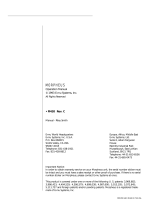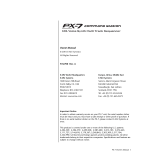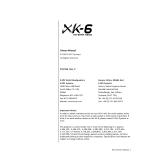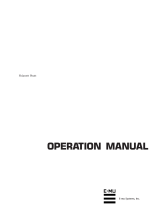Page is loading ...

1
AVP Synthesizers
MAD-5
MAD-5 Midi Analog Drum synthesizer
User Manual

2
MAD-5 is an analog drum synthesizer which is inspired by the sounds of the 20
th
century soviet drum machines while having the flexibility, MIDI control and
compact package of the 21
st
century. It consists of 22 knobs, 1 switch and 1
button which allows you to manipulate/control the sound and midi. It also has
individual outputs for each of the five drum instruments so you can easily rout
and process them separately with your external effects especially in a live
configuration.
Specification
- The method of synthesis: 100% analog synthesis;
- Drum instruments: five (bass drum, snare drum, open hat, close hat, clap);
- Noise Generators: four (for snare drum, open hat, close hat and clap);
- MIDI interface: MIDI In, 16 channels (Midi learn);
- Audio outputs: one mix output (mono 6.3mm jack) and five individual outputs
(mono 6.3mm jack);
- Controls: 22 knobs, 1 switch and 1 button;
- External power supply: adapter 15 VAC (included)
* MAD-5 operates on 220 volts, if used on 110 volts - a power converter from 220
to 110 volts is required. So if you are in a 110 volts area, please only use it with a
power converter. Without it, the unit will get damaged and will stop functioning.

3
Controls
Front panel
Rear panel

4
1. Bass Drum (BD): volume control (LEVEL), pitch control (TUNE), resonance
control (RESO), wave forms control (WAVE);
2. Snare Drum (SD): volume control (LEVEL), pitch control (TUNE), decay control
(DECAY), noise filter control (NOISE), frequency shift control (SWEEP);
3. Open Hat (OH): volume control (LEVEL), pitch control (TUNE), decay control
(DECAY);
4. Close Hat (CH): volume control (LEVEL), pitch control (TUNE), decay control
(DECAY);
5. Clap (CL): volume control (LEVEL), pitch control (TUNE), balance (BAL), clap’s
attack time control (SPACE), decay control (DECAY), noise filter control (NOISE);
6. Total volume control (VOLUME);
7. Power switch (POWER);
8. MIDI selection button, midi learn (MOD), MIDI indicator (SET);
9. MIDI connection (MIDI INPUT);
10. Mix audio output (MIX OUTPUT);
11. Individual drum instrument’s audio outputs (OUTPUTS);
12. Adapter jack (15 VAC).
Connecting MAD-5
Power (15 VAC adapter): Connect the power adapter to the POWER jack
Audio output (6.3mm jack): In order to connect to a mixer or other audio
interface/equipment, please insert a 6.3 mm mono jack into the MIX OUTPUT of
MAD-5 or in the Individual OUTPUTS;
MIDI Input: Connect the MIDI OUT port of the sequencer or MIDI keyboard (or
other MIDI device) to the MAD-5 MIDI IN port.

5
Setting the MIDI-channel
- In order to set the needed MIDI channel on the MAD-5 - a MODE button is used
which is located on the front panel just under the POWER switch. The 1
st
MIDI
channel is set by default. In order to change the MIDI channel, you have to hold
the MODE button while switching the POWER on;
- Indicator SET should start to blink;
- From your MIDI device/DAW/Sequencer by which you want to control MAD-5,
you have to send a midi message from a channel that you have assigned (for
example choose channel 2 on your device and press any key on your keyboard).
From there on the SET indicator will stop blinking meaning that the desired MIDI
channel has been set. It will be saved in the memory of MAD-5.
Powering on
Set the POWER switch to On. From that moment on MAD-5 is ready for action
Overview of controls
MAD-5 structure consists of five analog drum instruments sections.
Each of the drum instrument has a volume control (LEVEL).
In the BD section, the TUNE control allows to adjust the pitch tone of the bass
drum, RESO – resonance control, which in some positions of the knobs allows to
control the decay of the BD.
Note! When the TUNE knob positions is set somewhere from 4 until 8 and the
RESO knob is turned up, the BD starts to self-oscillate.
The WAVE control adjusts the form of the BD wave – from a sine wave form (left
position of the knob) to a square form (right position of the knob). Thus, the
WAVE control allows for quite a flexible sculpting of the BD tone.
In the SD section the TUNE control allows to adjust the pitch tone of the snare
drum, DECAY – to adjust the desired decay, SWEEP – frequency shift (the effect
applies in small proportions, maximum effect peak can be heard when the
positions of the SWEEP and TUNE knobs are turned fully clockwise).
The NOISE control adjusts the filter’s cutoff frequency of the NOISE generator.
In the OH section the TUNE control allows to adjust the pitch tone, DECAY –
adjusts the desired decay of the open hat.
In the CH section the TUNE control allows to adjust the pitch tone, DECAY –
adjusts the desired decay of the close hat.
In the CL section the TUNE control allows to adjust the pitch tone, SPACE – the
attack time of the clap. NOISE control adjusts the filter’s cutoff frequency of the

6
NOISE generator. DECAY control –the desired decay of the clap and BAL control –
the balance between the NOISE generator and a clap.
Note: At high volume settings, the OH and CH can be slightly heard (if pressed or
programmed) in the MIX OUTPUT even with their volume levels at 0, this is due to
the 80s type of schematics used which cannot be eliminated, in order to
overcome this we suggest to use the individual OUTPUTS;
Working with MIDI
Each of the drum instruments of the MAD-5 responds by pressing the respective
keys on the MIDI-keyboard, another MIDI trigger device, or when receiving MIDI
data from sequencer. When the drum instruments receive MIDI control
messages, the corresponding indicator lights start flashing.
The keyboard layout is shown below.
Keyboard layout
Control of drum instruments of the MAD-5 is triggered by the following notes:
BD (Bass Drum) – C1 (note «Do» of the first octave);
SD (Snare Drum) – D1, E1 (notes «Re» and «Mi» of the first octave);
OH (Open Hat) – F1, G1 (notes «Fa» and «Sol» of the first octave);
CH (Close Hat) – A1, B1 (notes «La» and «Si» of the first octave);
CL (Clap) – D# (note «D-sharp» of the first octave).
AVP Synthesizers
www.avpsynth.com
/






